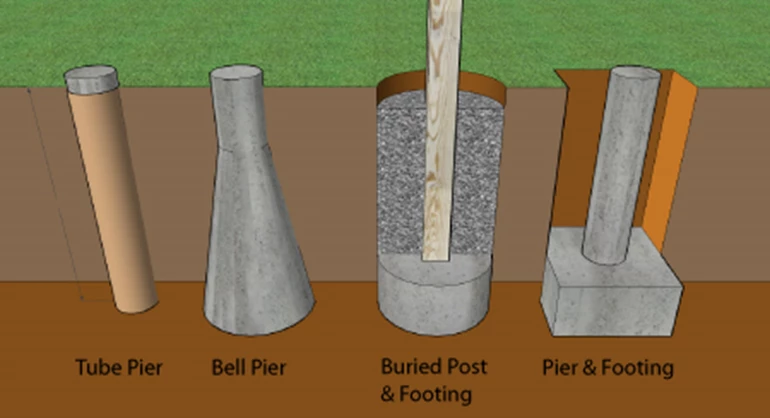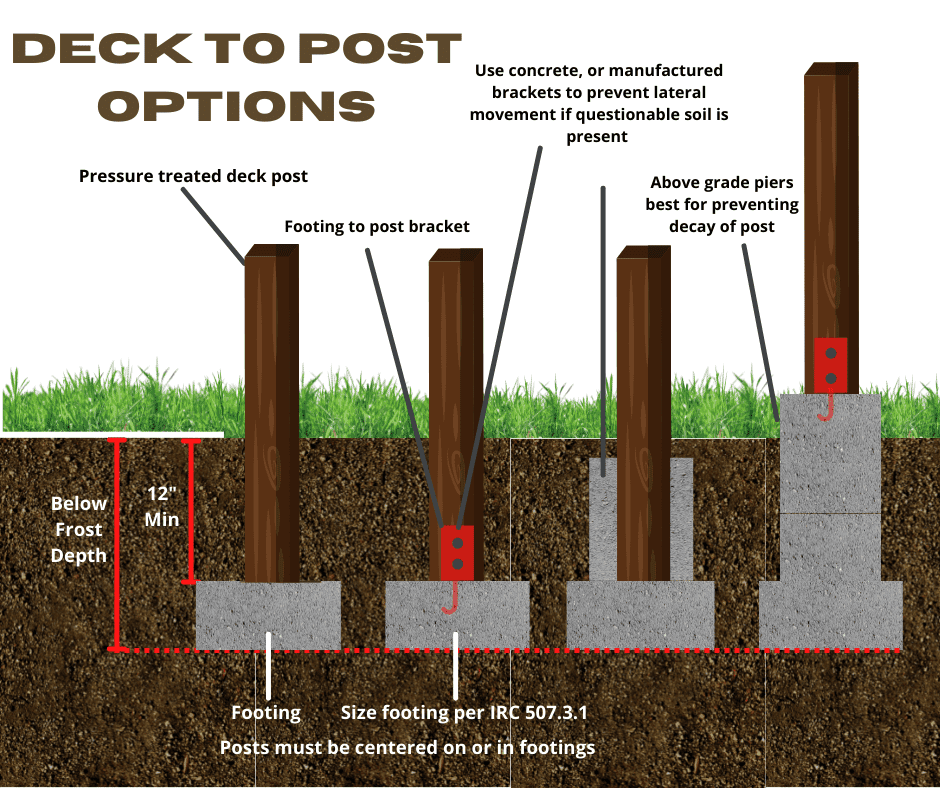Engineered for Success: The Scientific Research Behind Durable and Durable Deck Footings
Wiki Article
Professional Tips for Installing Deck Footings to Assistance Your Outdoor Area
When it comes to developing a deck, one of the most essential components to take into consideration is the installation of correct footings. These grounds are the foundation upon which your outside space will relax, giving security and assistance for years to come. What specifically does it take to mount deck footings appropriately?Relevance of Correct Deck Grounds
Correct deck footings are important for ensuring the security and durability of your exterior area. Without strong and effectively set up grounds, your deck may become unsteady, leading to safety threats and expensive repairs.
Along with security, appropriate deck grounds likewise add to the durability of your outdoor room (Deck Footings). Grounds that are developed and constructed to hold up against the components and soil problems in your location will certainly assist prevent the deck from changing or clearing up with time. By making sure the footings are effectively sized and mounted, you can reduce the risk of damages to the deck structure, expanding its life expectancy and decreasing the need for pricey repair services or replacements

Picking the Right Type of Footings
When selecting the suitable kind of grounds for your deck, it is necessary to take into consideration aspects such as dirt conditions, regional building codes, and the overall style of your outdoor area. The kind of footing you pick will play an essential function in ensuring the stability and longevity of your deck.One common type of ground is the concrete ground. Concrete grounds are suitable for many dirt problems and provide outstanding assistance for decks. They are commonly installed below the frost line to avoid moving and clearing up as a result of cold and thawing cycles. Another option is helical piers, which are perfect for areas with unsteady soil or high water tables. These piers are screwed into the ground and provide strong support for the deck.
In many cases, you might require to make use of customized grounds, such as stack footings or deep foundations, if you are building a large or multi-level deck. These grounds are created to disperse the weight of the deck over a larger area, guaranteeing stability and preventing settling or sinking.
Prior to selecting a sort of footing, it is vital to get in touch with neighborhood building regulations and policies to guarantee conformity. In addition, think about the design and intended use your outside area. Factors such as the size, form, and load-bearing needs of your deck will certainly influence the sort of footing that is most ideal.
Preparing the Ground for Footing Installment
To properly prepare the ground for footing installation, it is essential to evaluate the dirt conditions and take essential steps to ensure security and toughness of the deck. The primary step is to excavate the location where the footings will certainly be set up. The depth of the excavation will certainly depend on the frost line in your area and the particular requirements of the deck layout. It is crucial to eliminate any type of vegetation, rocks, or particles from the excavation to make certain a solid foundation.As soon as the location has been dug deep into, the following step is to small the dirt. This can be done utilizing a plate compactor or by making use of a hand tamper. Compacting the dirt helps to remove any spaces or air pockets, which can lead to resolving and instability over time.
After compacting the dirt, it is essential to lay a layer of gravel or smashed stone at the bottom of the excavation. This will certainly offer water drainage and help to avoid water from pooling around the grounds, which can result in disintegration and instability.
Step-by-Step Guide to Putting Up Deck Footings
After correctly preparing the ground for footing setup, the following action is to begin the process of setting up deck grounds. This step-by-step overview will certainly offer you with a clear understanding of exactly how to set up deck grounds for your exterior room.Establish the area: Start by noting the positions of the deck footings using stakes and string. Ensure that the locations align with the design and layout of your deck.
Dig the holes: Use a message opening digger or an auger to dig the openings for the grounds. The deepness and size of the openings need to be in conformity with local building regulations and the specific needs of your deck layout.
Degree the openings: Utilize a level to guarantee that the holes are dug to the correct deepness and are degree with each other. (Deck Footings)
Add crushed rock: Area a layer of crushed rock at the end of each hole to improve drainage and prevent the wood from rotting.
Insert the footings: Place the grounds into the openings, seeing to it they are degree and plumb. Make use of a degree and a determining tape to guarantee accuracy.
Secure the footings: Put concrete right into the holes around the footings, loading them to the top. Make use of a blog post degree to guarantee the footings remain degree as the concrete collections.
Enable time for healing: Let the concrete remedy according to the producer's directions before waging the deck building.
Typical Errors to Prevent During Footing Installation
One vital element to think about throughout the setup of deck grounds is preventing usual errors that can compromise the stability and longevity of your outside space. While deck grounds special info may feel like a simple and simple component of the building procedure, forgeting specific factors can bring about pricey repair services and prospective safety dangers down the line.
In addition, ignoring to set up proper water drainage procedures can cause water to gather around the footings, bring about rot, decay, and the ultimate weakening of the deck's structure. Using the wrong kind of footing product or falling short to adequately safeguard the footings can compromise their architectural honesty.
To avoid these blunders, it is important to seek advice from with a professional or comply with market standards to make certain proper footing setup. By doing so, you can make certain the security and longevity of your outside area, providing a delightful and safe setting for years ahead.
Conclusion
To conclude, setting up appropriate deck grounds is vital for the stability and longevity of your outdoor area. By selecting the appropriate kind of footings and adequately preparing the ground, you can guarantee a strong structure for have a peek at these guys your deck. Following a detailed overview and preventing usual mistakes throughout footing setup will certainly even more boost the toughness and safety of your deck.Correct deck grounds are vital for guaranteeing the stability and longevity of your exterior room. The grounds offer as a connection check here in between the ground and the deck, enabling the weight of the deck and its passengers to be spread equally into the dirt.One usual kind of footing is the concrete footing. Put the grounds: Put the grounds into the holes, making certain they are degree and plumb. Protect the footings: Pour concrete into the openings around the grounds, loading them to the top.
Report this wiki page